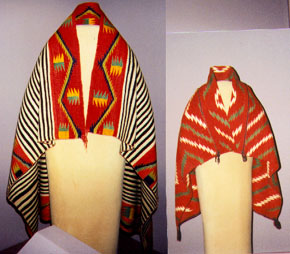Blankets*
They start here:
dirty and grey on the back of a sheep,
burred and twiggy,
a dark face bleating
and hoofs wet in the mud.
They start with that thick clump
sheared and shaken,
then taken and turned by the hand,
and go on where I stand
in New York City
at the blurred end of Manhattan
in January fog, the foghorns blatting
and the damp air white as wool.
When I stood with these blankets
that alter the walls,
old clothes
draped as if worn,
far from their homes in the striped rock canyons
and the herds where they were grown--
they held me, calm, in shaped colors,
good-humored, forgiving,
still turning
and changing the rooms--
as they were turned
when the weavers first lifted them,
singing, from the looms.
* "Woven by the Grandmothers," an
exhibition of nineteenth-century Navajo textiles, and "Contemporary
Weaving" from the Gloria F. Ross Collection, Denver Art
Museum, at the National Museum of the American Indian,
New York, 1997.




 Old Dine' (Navajo) batten.
Kina'alda'--Coming of Age
At 92, she sang.
Old Dine' (Navajo) batten.
Kina'alda'--Coming of Age
At 92, she sang.
The long words came out,
her voice still strong.
In a basket bowl
the ground-up clay lay,
white and warm.
She stood, and touched it
to our hands and face.
She sang the child into womanhood,
I still feel it on my cheeks--
the corn.
String Games
The world is a very narrow bridge,
and the main thing is not to fear at all.
These are the best words, here,
found in the face of crossings
over ravines and on paths
that cannot be retraced--
Here, in the branches and forks
where trees' images are shadows on rock
and our hands among them
are marking the ways.
Rocks at sunset, in Tse'yi.

These are hands swift and patient,
cutting. They move
in the bodies of animals
and on their flanks,
dappled in ochre and red.
They stitch through fur,
understanding death,
and make cradles that mimic the stars.
Weaving by Mae Gai, age 87, in Tse'yi', 1995.
Go to Weaving the Light,
page 4.
Return to Wings to Fly With
Publishing introduction.
Return to Migrations home page.
Go to Sea Mammals page.
Go to Listening to the
Stone page.
Write to: Migrations, P.O. Box 543, Newton, MA 02456
or email to: carol@migrations.com
to place an order, request photos, or for more information.
Copyright © 1997 Carol Snyder Halberstadt, Migrations. All
rights reserved.








